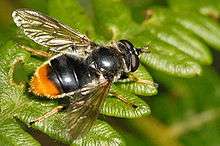Blera fallax
Blera fallax or the pine hoverfly is a rare species of hoverflies normally associated with mature pine tree in Northern and Central Europe.[1]
| Blera fallax | |
|---|---|
 | |
| female | |
| Scientific classification | |
| Kingdom: | |
| Phylum: | |
| Class: | |
| Order: | |
| Family: | |
| Subfamily: | |
| Tribe: | |
| Genus: | |
| Species: | B. fallax |
| Binomial name | |
| Blera fallax | |
| Synonyms | |
Biology
The pine hoverfly larva, which are of the rat-tailed maggot type, normally develop in damp rot holes of felled or fallen pine trees, notably the Scots pine (Pinus sylvestris), though it will occur with other conifers. Preference is for large stumps where there has been some heartwood softening by the fungus Phaeolus schweinitzii. Adult flies have been seen feeding on wild raspberry flowers, but little else is known about adult behaviour.[2]
Conservation
In Scotland, attempts have been made on RSPB sites to create artificial rot holes in felled pine stumps. This has led to a slight increase in numbers of adults in some areas, though numbers are still very low and causing some concern.[2]
References
- Stubbs, Alan E.; Falk, Steven J. (1983). British Hoverflies: An Illustrated Identification Guide (2nd ed.). London: British Entomological and Natural History Society. pp. 1–253, i–xv. ISBN 1-899935-03-7.
- MacGowan, Iain (2008). "Blera fallax". Bulletin of the Dipterists Forum (print). UK: The Dipterists Forum (66): 14–15. ISSN 1358-5029.
External links
![]()